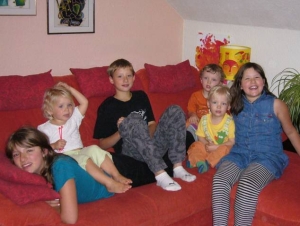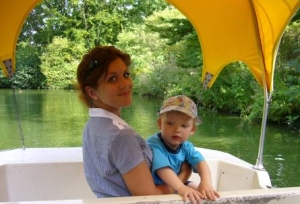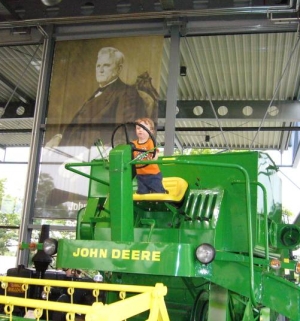Genetics Conjectures in German
 Wednesday, February 4, 2009 at 5:15PM
Wednesday, February 4, 2009 at 5:15PM Since the boys were born, we’ve spoken German to them, but English to one another. The reward for this effort came soon after we arrived in Mannheim. Wiki had been refusing to speak German in Australia for some time, probably because he had decided it must be a baby language, nothing for big boys like him. He soon found that even grown-ups spoke German in Mannheim, and his rapid switch of tongue was impressive. While Loxon still used the odd English sentence, there was nothing but German from Wiki. We soon decided it was time to switch to English when speaking to them.
It is a strange feeling to change to a new language after speaking with your child in another one for all of their lives. Every little phrase that has become part of the daily routine suddenly is different. In some cases, it is hard to remember the words for certain things, even in your native tongue, because you are so accustomed to using the word in the other language. Imagine that, in the middle of changing your child — something you have done literally more than a thousand times — you forget the English word for nappy, and are forced to cram the German word (Windel) into an otherwise ordinary English sentence. The sensation nibbles somewhere around the edges of your identity. How is it possible to forget the word ‘nappy’? Doing so while remaining a highly-skilled nappy user, felt like good evidence against the Sapir-Whorf hypothesis and its modern variants.
Conversely, speaking German to adults in the normal course of life was exhausting. While my German vocabulary was well-equipped with words for nursery objects, it was rather brittle in the broader world of shopping malls, family gatherings and, as it happened, genetics. In the week after we arrived, Opa Günther had his 74th birthday party, and for the first time all six of his grandchildren were together.  Wiki and Loxon’s other three cousins, Leonie and twins Olivia and Alexander, are a little older, but were just as excited to meet the boys. Our pediatrician back in Australia had told us that Marion’s brother having twins means Marion is also more likely to do so. And it is hard to argue given that the background twinning rate without fertility treatments is around 1 in 80 pregnancies. So far though only Danny Yee has been able to propose a mechanism to explain what Marion could share with her brother that would make having twins more probable. The details are too complex to go into here, but trying to explain them to the family at the party definitely gave my German a work out.
Wiki and Loxon’s other three cousins, Leonie and twins Olivia and Alexander, are a little older, but were just as excited to meet the boys. Our pediatrician back in Australia had told us that Marion’s brother having twins means Marion is also more likely to do so. And it is hard to argue given that the background twinning rate without fertility treatments is around 1 in 80 pregnancies. So far though only Danny Yee has been able to propose a mechanism to explain what Marion could share with her brother that would make having twins more probable. The details are too complex to go into here, but trying to explain them to the family at the party definitely gave my German a work out.
While we were in Mannheim, Sabine introduced us to the wonderful pool centre in Schwetzingen called Bellamar, which has tiled sliding embankments, a giant spiral slide and in-pool tunnels leading to dimly lit grottos, along with the usual assortment of spas and saunas. The boys leapt straight in, and even demanded a trip down the giant spiral. Loxon was a little shocked when he was plunged into the deep pool at the end of the trip, but he took it in his stride (well, in his dog paddle anyway).
One of our German helpers in Australia, Derya, who is now back studying in Bonn, also came to visit us.  She gave the boys a puppet with which she had grown up, called Der kleine Maulwurf (the little mole), who is a popular cartoon character in Germany (although he is actually Polish). His delicious short cartoons are all available on You Tube and make a great 5 minute distraction for little ones.
She gave the boys a puppet with which she had grown up, called Der kleine Maulwurf (the little mole), who is a popular cartoon character in Germany (although he is actually Polish). His delicious short cartoons are all available on You Tube and make a great 5 minute distraction for little ones.
Other highlights of our stay in Mannheim included two museum visits. One was the Landesmuseum für Technik und Arbeit, which is phenomenally technical, well beyond what any three-year old, and probably most thirty-three year olds, could comprehend. But the boys had fun pressing the buttons and watching strange objects jerk, swing, spin and light up. We were too late to watch the daily cranking up of the old steam locomotive, but we did manage to operate a giant bellows — large enough to require two 15 kilo people to stand on it — that sent a message cannister whizzing through a pipe up to the ceiling and back.
The other was the John Deere factory, which has tractors on display from the 1921 Lanz Bulldog through to modern air-conditioned monsters whose tyres are higher than most people can reach.  All these are crawlable over and through, but fortunately the keys had been removed from those in working order. Although I suppose watching a tractor bounce out through the glass walls with Loxon at the helm would have offered stunning, if short-lived, entertainment.
All these are crawlable over and through, but fortunately the keys had been removed from those in working order. Although I suppose watching a tractor bounce out through the glass walls with Loxon at the helm would have offered stunning, if short-lived, entertainment.
Finally, our next stop was Basel.
